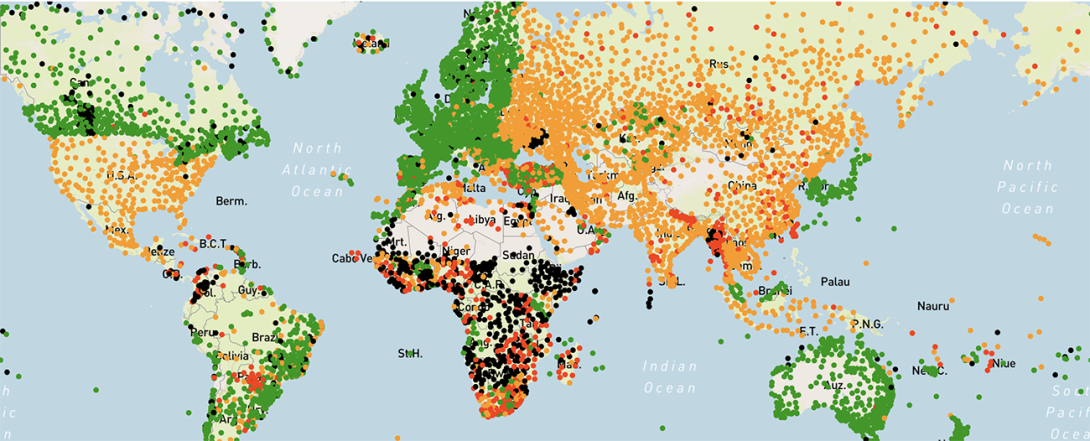A new module to monitor the Global Basic Observation Network (GBON) was made available in the latest major release in May 2023 (version 1.4.0) of the graphical web-based interface created for the WIGOS (WMO Integrated Global Observing System) Data Quality Monitoring System (WDQMS). This module provides the essential tool to assist the World Meteorological Organization (WMO) in the implementation and compliance monitoring of GBON that came into force on 1 January 2023. ECMWF is one of four centres supplying near-real-time monitoring information to GBON.

Significance of GBON
GBON is the WMO response to the urgent need to strengthen surface-based observation capabilities to support numerical weather prediction (NWP) and climate activities. In recent decades, satellites have taken over as the primary source of observations for NWP, offering an enormous quantity of observations with consistent geographical and temporal coverage of the atmosphere. However, some critical variables, such as surface pressure or winds, cannot be accurately measured from space. For these, global NWP systems continue to rely on surface-based observations. While in some parts of the world these observations are available in abundance, in others they are scarce or even non-existent. Large geographical gaps in the availability of such ground-based observations have driven the GBON initiative.
In 2019, WMO Members agreed to establish GBON. This international agreement, based on a global optimal design, establishes clear requirements for countries to acquire and internationally exchange surface-based observations of the most important weather and climate variables. Six land-based variables – atmospheric pressure, temperature, humidity, wind speed, precipitation, and snow depth – have been designated as the most essential for global NWP and climate data reanalysis purposes. Furthermore, WMO Members are required to measure and report these variables hourly in the case of surface land stations and twice per day for upper-air (radiosonde) land stations. These GBON requirements are applied to stations registered in OSCAR/Surface that have been affiliated to GBON by WMO Members.
Role of four NWP centres
The GBON module, like the near-real-time NWP monitoring module in the WDQMS webtool (https://wdqms.wmo.int/), also relies on near-real-time monitoring information received from four participating centres that deliver global NWP: the German Meteorological Service (Deutscher Wetterdienst – DWD), ECMWF, the Japan Meteorological Agency (JMA) and the United States National Centers for Environmental Prediction (NCEP). The GBON module monitors all GBON-affiliated surface land stations and upper-air stations on land. This module assesses GBON station-level compliance using data availability as the primary performance measure. The near-real-time monitoring information provided by the four NWP centres is aggregated by station, variable, and time interval. The calculated total number of reports is then compared against the corresponding thresholds established by the GBON compliance criteria (mentioned above) for the two different station types.
An example of the daily GBON monitoring pages for all GBON-affiliated land surface stations that are required to provide surface pressure (one of the mandatory variables) is shown in the figure. It is evident that some regions of the world are consistently providing surface pressure observations to the NWP centres (shown by green dots). Other parts of the globe, on the other hand, have spatial availability gaps (shown by black dots) and temporal availability gaps (shown by orange and red dots). These gaps in data availability are the result of either missed observations or observations that were made but not shared internationally. It is worth noting that encouraging WMO Members to register their existing stations as GBON and making them compliant with requirements is an important component at this stage of the GBON implementation. The next stage towards achieving a global optimal design of the land-based network will involve installing new stations to provide sparse areas with better spatial and temporal coverage.
Plans for the future
The implemented GBON module currently only considers availability to monitor GBON station-level compliance. However, the plan is to incorporate quality requirements into the monitoring of GBON stations in the near future. This is extremely important since it supports the WMO's aim to enhance the quality of weather and climate information through the provision of not just more but also better observations. Meanwhile, the Infrastructure Commission is looking into GBON expansion in other domains. The aim is to first extend GBON to hydrology and the cryosphere, for which discussions have just started, followed by climate monitoring, the ocean and atmospheric composition. Also noteworthy is the creation of the Systematic Observations Financing Facility (SOFF), a funding mechanism of the WMO in partnership with the United Nations Development Programme (UNDP) and the United Nations Environment Programme (UNEP), to support the implementation and operation of GBON. This seeks to deliver long-term financial and technical help to countries with the biggest observational gaps, currently to least developed countries and Small Island Developing States. The goal is to enable the generation and international sharing of fundamental weather and climate observations in a sustainable manner.
